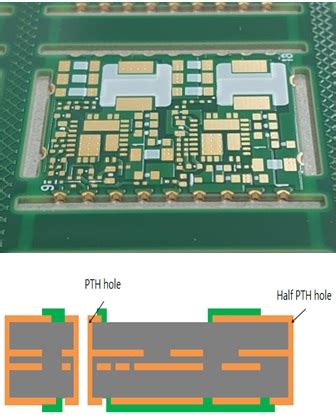Understanding PCB edge distance
PCB edge distance refers to the minimum space required between the edge of a PCB and the nearest hole or component pad. This distance is essential to maintain the structural stability of the PCB and prevent damage during the manufacturing process, assembly, and everyday use.
Factors Affecting PCB Edge Distance
Several factors influence the minimum hole distance to the edge of a PCB:
- PCB thickness
- Hole size
- Copper weight
- Manufacturing process
- Application requirements
PCB Thickness
The thickness of a PCB directly impacts the minimum hole distance to the edge. Thicker PCBs require a larger edge distance to maintain structural integrity and prevent breakage during handling and assembly. The following table provides general guidelines for minimum edge distance based on PCB thickness:
| PCB Thickness (mm) | Minimum Edge Distance (mm) |
|---|---|
| 0.8 | 0.5 |
| 1.0 | 0.6 |
| 1.2 | 0.7 |
| 1.6 | 0.8 |
| 2.0 | 1.0 |
Hole Size
The size of the holes drilled in a PCB also affects the minimum edge distance. Larger holes require a greater distance from the edge to prevent weakening the board’s structure. The table below offers guidance on minimum edge distance based on hole size:
| Hole Diameter (mm) | Minimum Edge Distance (mm) |
|---|---|
| 0.3 | 0.4 |
| 0.5 | 0.5 |
| 0.8 | 0.6 |
| 1.0 | 0.7 |
| 1.5 | 0.8 |
Copper Weight
The copper weight of a PCB, measured in ounces per square foot (oz/ft²), can influence the minimum hole distance to the edge. Higher copper weights may require increased edge distance to ensure proper adhesion between the copper and the substrate. The following table provides recommendations for minimum edge distance based on copper weight:
| Copper Weight (oz/ft²) | Minimum Edge Distance (mm) |
|---|---|
| 0.5 | 0.5 |
| 1.0 | 0.6 |
| 2.0 | 0.7 |
| 3.0 | 0.8 |
Manufacturing Process
The manufacturing process used to fabricate a PCB can impact the minimum hole distance to the edge. Different processes, such as punching, routing, or v-scoring, may have varying requirements for edge distance to ensure clean and accurate cuts. Consult with your PCB manufacturer to determine the appropriate edge distance for your chosen manufacturing process.
Application Requirements
The specific application of a PCB may dictate additional requirements for minimum hole distance to the edge. For example, PCBs used in high-vibration environments or subject to mechanical stress may require increased edge distance to withstand the additional forces. Consider the end-use of your PCB when determining the appropriate edge distance.
PCB Design Guidelines for Optimal Edge Distance
To ensure the best performance and manufacturability of your PCB, follow these design guidelines related to edge distance:
- Adhere to the minimum edge distance recommendations based on PCB thickness, hole size, and copper weight.
- Provide additional clearance for high-stress areas or components near the edge of the PCB.
- Avoid placing critical components or traces near the edge of the board to minimize the risk of damage.
- Consider using additional mechanical support, such as brackets or stiffeners, for PCBs with large components near the edges.
- Communicate with your PCB manufacturer to ensure that your design meets their specific requirements for edge distance and manufacturability.
FAQ
-
What happens if the hole distance to the edge of a PCB is too small?
If the hole distance to the edge of a PCB is too small, it can compromise the structural integrity of the board. This can lead to cracking, warping, or breaking during handling, assembly, or use, potentially causing component failure or complete board malfunction. -
Can I use the same edge distance for all PCB thicknesses?
No, it is not recommended to use the same edge distance for all PCB thicknesses. Thicker PCBs require a larger edge distance to maintain structural stability, while thinner PCBs may allow for smaller edge distances. Always refer to the recommended minimum edge distance based on the specific thickness of your PCB. -
How does the manufacturing process affect the minimum hole distance to the edge?
Different manufacturing processes, such as punching, routing, or v-scoring, may have varying requirements for minimum edge distance. These requirements ensure clean and accurate cuts during the fabrication process. It is essential to consult with your PCB manufacturer to determine the appropriate edge distance for your chosen manufacturing process. -
What should I do if my PCB design requires components near the edge of the board?
If your PCB design requires components near the edge of the board, consider providing additional clearance around these components to minimize the risk of damage. In some cases, using additional mechanical support, such as brackets or stiffeners, can help reinforce the PCB and protect components near the edges. -
Can I reduce the minimum hole distance to the edge to save space on my PCB?
While reducing the minimum hole distance to the edge may seem like a way to save space on your PCB, it is not recommended to compromise on this crucial design aspect. Adhering to the recommended minimum edge distance ensures the structural integrity and reliability of your PCB, which is essential for long-term performance and durability.

Conclusion
Determining the appropriate minimum hole distance to the edge of a PCB is a critical aspect of PCB design. By considering factors such as PCB thickness, hole size, copper weight, manufacturing process, and application requirements, designers can ensure the structural integrity and manufacturability of their PCBs. Adhering to the recommended guidelines for minimum edge distance and collaborating with PCB manufacturers can help create reliable and high-performing PCBs for a wide range of applications.

No responses yet